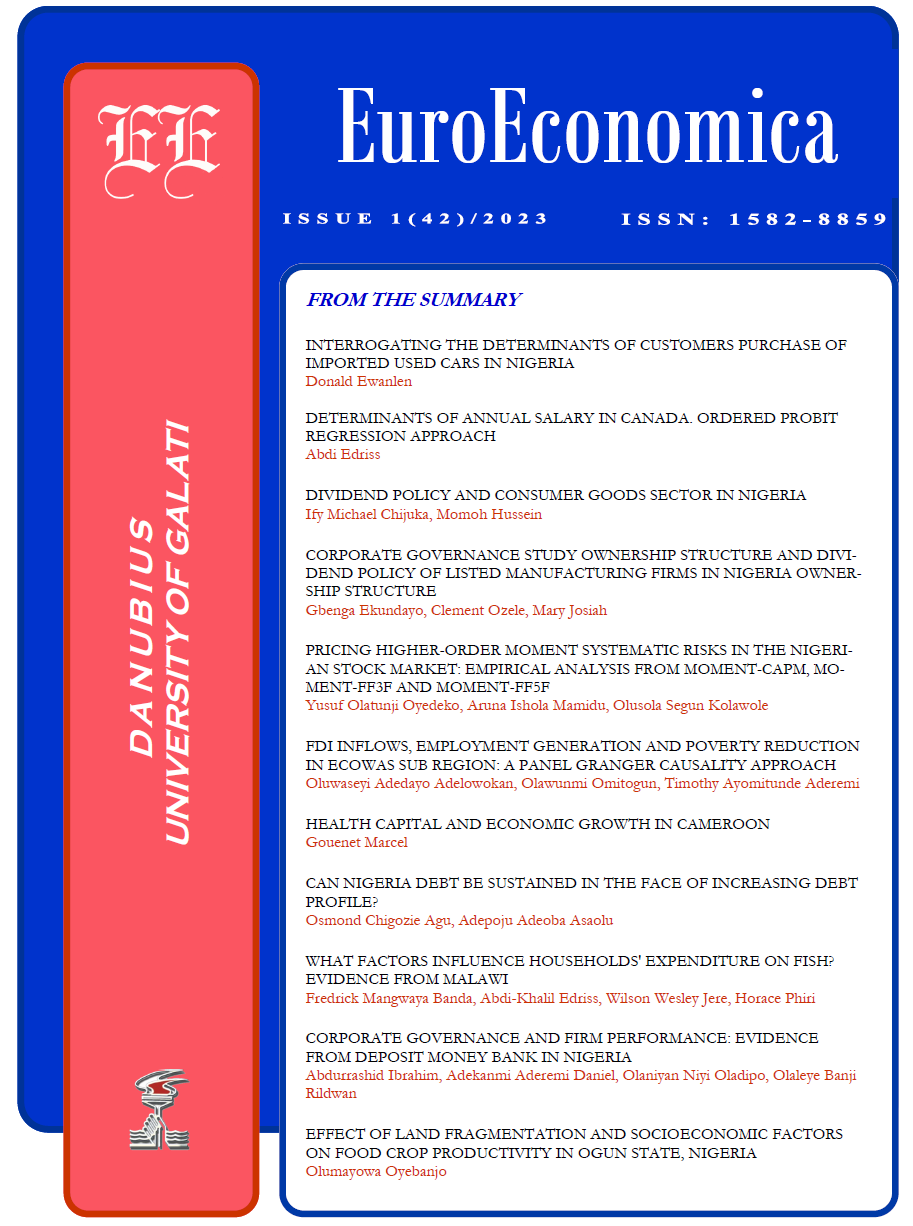Corporate Governance and Firm Performance: Evidence from Deposit Money Bank in Nigeria
Keywords:
Corporate Governance Board of Directors; Managerial Ownership; Profit AfterAbstract
This study examined the effect of corporate governance on firm performance in Nigeria, It specifically examined the effect of board director and managerial ownership on profit after tax of listed deposit money bank in Nigeria. Secondary source of data were employed through ex post facto research design. Census sampling technique was employed for the fourteen listed Deposit Money Bank spanning for the period of 2010-2020 .84 observation were assessed using multiple regression model. A strong multiple regression model was used to analyze the nexus between board of directors and managerial ownership. The multiple regression result of the findings showed that board size has positive and significant effect on profit after tax with a coefficient of 0.319 at 0.005 level of significance, while managerial ownership has negative and significant effect on profit after tax with a coefficient of 0.102 at 0.005 level of significant (p=0.045).It was concluded that corporate governance has significant effect of firm performance of listed Deposit Money Bank in Nigeria Exchange Group. However it was recommended that agency problem between manager and owners may be mitigated by keeping managerial ownership stake in a company low. This can assist keep costs down in the event of bankruptcy and provide for better oversight and control of management. With improved corporate governance provided by a larger board, firms may find it less difficult to get access to cheaper types of external capital, hastening the desired leverage ratio.
References
Abor, J. 2007. “Corporate Governance and Financing Decisions of Ghanaian Listed Firms.” Corporate Governance: The International Journal of Business in Society 7 (1): 83–92. doi:10.1108/14720700710727131.
Adachi-Sato, M., and C. Vithessonthi. 2019. “Corporate Debt Maturity and Future Firm Performance Volatility.” International Review of Economics and Finance 60: 216–237. doi:10.1016/j.iref.2018.11.001.
Anderson, R., S. Mansi, and D. Reeb. 2004. “Board Characteristics, Accounting Report Integrity and the Cost of Debt.” Journal of Accounting and Economics 37 (3): 315–342. doi:10.1016/j.jacceco.2004.01.004.
Aoki, H. 2004. “Boardroom Reform in Japanese Business: An Analysis of the Introduction of the Executive Officer System and Its Effects.” Asian Business & Management 3 (2): 173–199. doi:10.1057/palgrave.abm.9200085.
Arellano, M., and O. Bover. 1995. “Another Look at the Instrumental Variable Estimation of Error-Component Models.” Journal of Econometrics 68 (1): 29–52. doi:10. 1016/0304- 4076(94)01642-D.
Berger, P. G., E. Ofek, and D. L. Yermack. 1997. “Managerial Entrenchment and Capital Structure Decisions.” The Journal of Finance 52 (4): 1411–1438. doi:10.1111/j.1540- 6261.1997.tb01115.x.
Brailsford, T. J., B. R. Oliver, and S. L. H. Pua. 1999. “Theory and Evidence on the Relationship Between Ownership Structure and Capital Structure.” Department of Commerce, Australian National University Paper. 1–34.
.
Ranti, U. O. 2013. “The Effects of Board Size and CEO Duality on Firms’ Capital Structure: A Study of Selected Listed Firms in Nigeria.” Asian Economic and Financial Review 3 (8): 1033.
Shoaib, K., and S. Yasushi. 2015. “Capital Structure and Managerial Ownership: Evidence from Pakistan.” Business and Economic Horizons 11 (2): 131–142. doi:10.15208/beh. 2015.10.
Short, H., K. Keasey, and D. Duxbury. 2002. “Capital Structure, Management Ownership and Large External Shareholders: A UK Analysis.” International Journal of the Economics of Business 9 (3): 375–399. doi:10.1080/ 1357151021000010382.
Singh, S., N. Tabassum, T. K. Darwish, and G. Batsakis. 2018. “Corporate Governance and Tobin’s Q as a Measure of Organizational Performance.” British Journal of Management 29 (1): 171–190. doi:10.1111/1467-8551.12237.
Sumani, S. 2012. “Determinan Struktur Modal Dan Nilai Perusahaan Pertambangan Pasca UU Nomor 4 Tahun 2009.” Jurnal Ekonomi Dan Keuangan 80: 24–41.
Svirydzenka, K., 2016. “Introducing a New Broad-Based Index of Financial Development.” IMF Working papers WP/16/5. Washington, DC. [online] Accessed 30 August 2021. https://www.imf.org/en/Publications/WP/Issues
Tse, C. B., and J. Y. Jia. 2007. “The Impacts of Corporate Ownership Structure on Incentive of Using Capital Structure to Signal.” Studies in Economics and Finance 24 (2): 156–181. doi:10.1108/10867370710756192.
Vijayakumaran, R. 2021. “Impact of Managerial Ownership on Investment and Liquidity Constraints: Evidence from Chinese Listed Companies.” Research in International Business and Finance 55 (C): 1–18. doi:10.1016/j.ribaf.2020.101321.
Wansley, J. W., M. C. Collins, and A. S. Dutta. 1996. “Further Evidence on the Relation Between Corporate Ownership Structure and Debt Policy.” Managerial Finance 22 (2): 56–75. doi:10.1108/eb018549.
Wen, Y., K. Rwegasira, and J. Bilderbeek. 2002. “Corporate Governance and Capital Structure Decisions of Chinese Listed Firms.” Corporate Governance: An International Review 10 (2): 75–83. doi:10.1111/1467-8683.00271.
Yermack, D. 1996. “Higher Market Valuation of Companies with a Small Board of Directors.” Journal of Financial Economics 40 (2): 185–211. doi:10.1016/0304-405X(95) 00844-5.
Yoshikawa, T., and P. H. Phan. 2003. “The Performance Implications of Ownership-Driven Governance Reform.” European Management Journal 21 (6): 698–706. doi:10. 1016/j.emj.2003.09.013.
Yusuf, M. R., and L. K. Sulung . 2019. “Experience, Board Size, and Firm Capital Structure“. 3rd Asia-Pacific Research in Social Sciences and Humanities Universitas Indonesia Conference (APRISH 2018). Advances in Social Science, Education and Humanities Research, 348. . ”.” In . Vol. (Atlantis Press). 232–238 doi:10.2991/aprish-18.2019.29 .
Zeitun, R., and G. Haq. 2015. “Debt Maturity, Financial Crisis and Corporate Performance in GCC Countries: A Dynamic-GM Approach.” Afro-Asian Journal of Finance and Accounting 5 (3): 231–247. doi:10.1504/AAJFA.2015. 070291.
Zhang, R., and Y. Kanazaki. 2007. “Testing Static Tradeoff Against Pecking Order Models of Capital Structure in Japanese Firms.” International Journal of Accounting and Information Management 15 (2): 24–36. doi:10.1108/ 18347640710837335.
Downloads
Published
How to Cite
Issue
Section
License
Copyright (c) 2023 Abdurrashid Ibrahim, Adekanmi Aderemi Daniel, Olaniyan Niyi Oladipo, Olaleye Banji Rildwan

This work is licensed under a Creative Commons Attribution-NonCommercial 4.0 International License.
The author fully assumes the content originality and the holograph signature makes him responsible in case of trial.


